Growing in the farmer’s fields at this time of year are crops that were planted last fall, like wheat or grass. If crops were not planted to overwinter, then weeds have taken hold and many of them are now flowering.
After winter and early spring the ground is wet and must dry out enough before farmers can work the soil. Tractors can’t get into the fields when the soil is too wet or there is a great chance of getting stuck in the mud. Besides, the soil has to be dry enough to be able to be tilled or planted.
Environmentally-minded farmers will plant fall crops to protect the soil and to keep weeds at a minimum. Doesn’t it make sense to plant a crop in the fall to save the topsoil from blowing away? Even if it’s not a cash crop, the benefit to the farmer and the environment is great. Why not plant a crop that could be turned under instead of letting weeds grow that will be sprayed with herbicides that pollute the air, water and soil?
Weeds will grow where ever they can. If there is bare land, weeds will try to grow on it. Weeds can be defined as “plants that grow where you don’t want them to grow”. So, anything growing in a farmer’s field that the farmer didn’t plant can be called a weed.
Field weeds are those types of plants that quickly colonize empty areas, especially areas with little competition. Open fields certainly fit that description and are the perfect places for weeds to grow explosively.
An example of these field weeds can be found in a nearby field. From a distance you can see some “green” plants growing with a few colorful spots here and there.
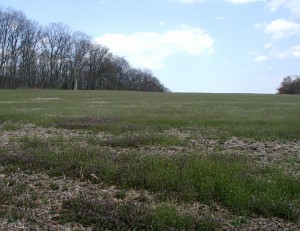
On closer inspection one can see that two field weeds have exploded to overtake most of the field. This field is typically planted with corn or soybeans, but right now it’s filled with Pennsylvania bittercress and purple dead nettle.
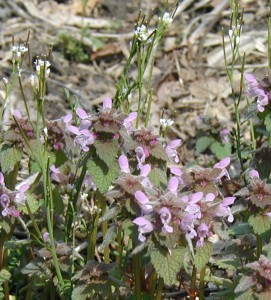
The taller weed with the little white flowers is Pennsylvania bittercress. Note the long seed pods sticking straight up. Setting seed so early in the growing season guarantees that we’ll see this weed again next year. PA bittercress has basal leaves to collect sunlight and the energy needed for the plant to flower and reproduce. It is large enough to reproduce before its purple co-hort has grown to any size, so competition between the two is reduced and they can flourish together.
The purple dead nettle flowers are irregular in shape having one large upper lip forming a sort of hood and two lobes on the lower “lip” with each flaring out to a side. The blooms are light purple to lilac on the outside and spotted on the inside.
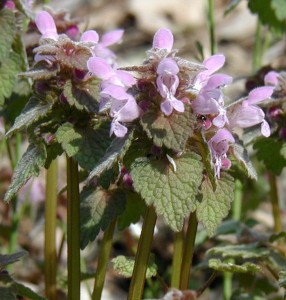
Blooms peak out from under each layer of leaves and several flowers are open at any given time. The triangular, heavily-veined leaves appear quite uniform as they arise from the four sides of the square stem.
Different weeds occur in different fields. We drove by one the other day that was completely filled with field peppergrass. (Below images taken 18Apr2010, above images taken 5Apr2010.)
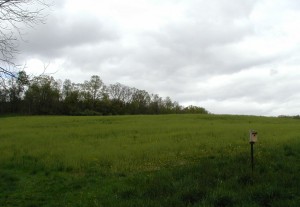
In the image above the light green weeds in the farmer’s field is peppergrass. Unless you know your food crops, the above field almost looks planted for a purpose. The field peppergrass is an alien plant, which are known for taking over areas. With a huge seed production it’s no wonder that this plant will seem like a perennial, coming back year after year.
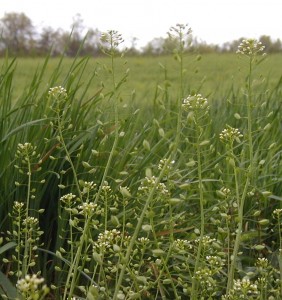
Field peppergrass is similar to Shepard’s purse, another member of the Mustard Family. Mustards start blooming in early Spring, as witnessed by the white-blooming garlic mustard that we see practically everywhere. In other places fallow fields are showing yellow with blooming field mustards.
![Reblog this post [with Zemanta]](http://img.zemanta.com/reblog_e.png?x-id=738363b3-0a4a-44ec-8a6c-9c8dbf89d1d0)